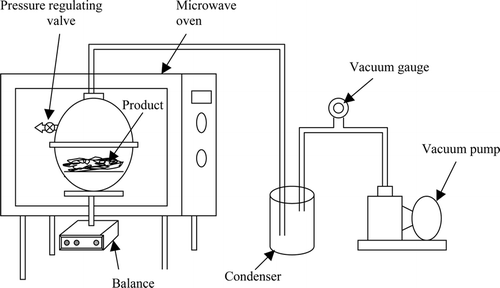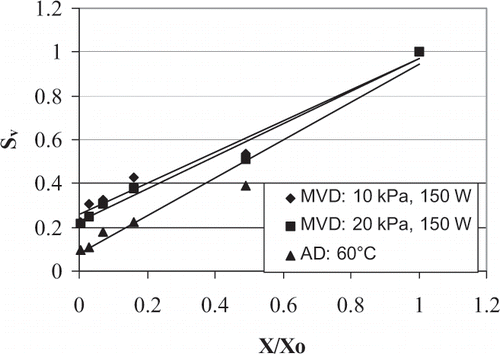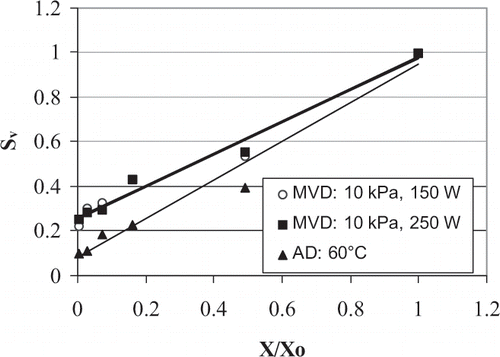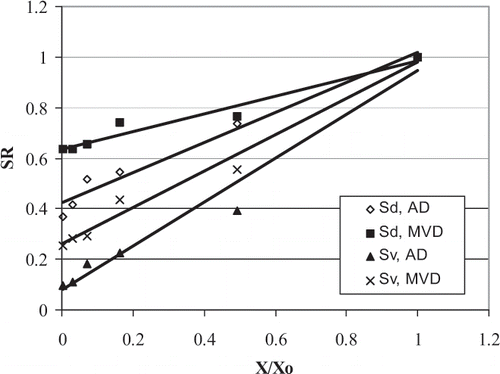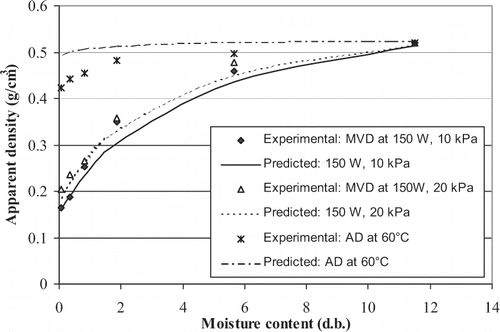Abstract
Shrinkage characteristics and apparent density of whole button mushrooms were determined at various moisture content levels (ranging from 5 to 92% wet basis) during microwave-vacuum drying at two different power (150 and 250 W) and pressure (10 and 20 kPa) levels. The above properties during convective hot air drying at 60°C were also measured for comparison. In both microwave-vacuum and air-drying methods, the shrinkage (volumetric and diametric) of mushroom showed a linear behavior with moisture content. Experimental data showed that the effect of the system pressure on shrinkage and density was more significant than the power level during microwave-vacuum drying. Moisture content and method of drying also affected shrinkage statistically. Microwave vacuum drying produced less shrinkage than air drying. Simple mathematical models were used to correlate the above properties with the material moisture content. The models were fitted to experimental data satisfactorily, and the parameters were estimated.
INTRODUCTION
Food materials undergo multiple changes during drying, including modification of the physical and chemical structure that ultimately affects the quality of the dehydrated foods. Change in moisture during dehydration of high moisture materials like fruits and vegetables induce change in shape, density and porosity. Karel[Citation1] listed the followings as the important physical changes affecting quality of dehydrated foods: shrinkage of cells, loss of rehydration ability, wettability, and case hardening. Many porous food materials undergo volume changes upon uptake or loss of water. During drying, when there is water loss, the volume change is expressed as shrinkage. Shrinkage is often considered negligible during modeling of the drying processes. However, shrinkage is seldom negligible in these foods. Shrinkage of food products during drying takes place simultaneously with moisture diffusion, and thus affects the moisture removal rate. Rahman[Citation2] presented various theories explaining the process of shrinkage and collapse during drying. Among the various factors affecting pore formation like glass transition temperature, surface tension, structure, environmental pressure and mechanism of moisture transport, he hypothesized that the capillary force (suction) created by a receding liquid meniscus is the main force of collapse and counterbalancing this force causes formation of pores and lower shrinkage. The counterbalancing force could be strengthening the solid matrix (ice formation, case hardening, and matrix reinforcement), generation of internal pressure, mechanism of moisture transport, and environmental pressure. Thus the extent of shrinkage also depends upon methods and rate of drying, and drying environments (air, vacuum or any inert gas).[Citation3–7] Shrinkage affects the physical properties of materials such as bulk density and porosity. A study of the shrinkage phenomena is thus important for a better understanding of the drying process and to control the characteristics of the product.[Citation8]
Shrinkage of different foods like seeds, grains, fruits, fish fleshes etc, is reported in several studies,[Citation3,Citation9–16] where shrinkage is shown as a function of total water content of the foods. Volume changes of individual particles were expressed as a bulk shrinkage ratio of sample volume at any time to initial volume. Most of these studies were conducted during convective air-drying. There is little published data on shrinkage and density changes of food materials like fruits and vegetables as a function of moisture content during microwave assisted drying. The objective of this study was to evaluate and correlate shrinkage with moisture content during drying of whole button mushrooms under various operating conditions and by different methods (microwave-vacuum and convective air). The influence of varying drying conditions is also investigated. A model to predict apparent density as a function of moisture content and shrinkage co-efficient is proposed and compared with experimental results.
THEORETICAL MODELS FOR PREDICTING FOOD PROPERTIES DURING DRYING
It has been proposed to incorporate the volume change into the diffusion coefficient in order to solve the shrinkage effect on transport properties during drying. Crank[Citation17] and Fish[Citation18] suggested to multiply the diffusion coefficient by a power of the volume changing factor, which is the ratio between the actual volume and a reference volume that is either the basic initial volume[Citation17] or the volume of the totally dried samples.[Citation18] The power exponent used by Crank was 2 and by Fish, 2/3. Gekas et al.[Citation19] and Gekas and Lamberg[Citation20] have shown that the shrinkage during drying of meat and potato was neither ideally three-dimensional, nor one-dimensional. They suggested the equation for diffusion coefficient as follows:
If the volume change is correlated with sample water content, it is then possible to substitute Deff and solve Fick's second law with appropriate boundary conditions, provided Dref is known from other experiments or from literature. Several models have also been proposed to predict physical properties of food materials like bulk density, true density, porosity etc. during drying. Lozano et al.[Citation9] developed a general model to correlate shrinkage properties for fruits and vegetables like apple, pear, potato, carrot and garlic. They suggested two alternative approaches. The first, considers porosity to depend on the shrinkage of the sample overall dimensions, while the second, takes into account the shrinkage of the cells consisting of the cellular tissue of the material. Rahman and Potluri[Citation12] proposed theoretical models based on conservation of mass and volume to predict bulk shrinkage and apparent density of squid flesh during air drying. They found the shrinkage in the direction parallel to muscle fibers was significantly different from that perpendicular to the fibers, which was different from the isotropic shrinkage of most fruits and vegetables. Shrinkage, density and porosity of garlic during drying were investigated.[Citation21] Shrinkage was based on dimensional changes in garlic slabs and it was found to be fiber-oriented and different from the reported isotropic shrinkage of fruits and vegetables. A general density model was also proposed by them. Zogzas et al.,[Citation22] developed a simple mathematical model to predict the physical properties like bulk density, particle density, shrinkage and porosity of different fruits, and vegetables during drying. The model predicted the previously stated properties versus material moisture content using four parameters, e.g., enclosed water density, dry solids density, bulk density of dry solids, and volume shrinkage co-efficient. Rahman et al.[Citation23] derived shrinkage and porosity of meat during air drying from the experimental density data and correlated them empirically. A theoretical model to predict porosity in foods during drying is developed by introducing a shrinkage-expansion coefficient in case of non-ideal conditions.[Citation24] Moreira et al.[Citation25] proposed a model to predict bulk density of materials during drying using one single parameter (volumetric shrinkage) and the actual density of the fresh materials. By determining the volumetric shrinkage during drying, the apparent density can be predicted taking into account the following dry mass balance relationship.[Citation12,Citation25]
The shrinkage ratio can be related to product moisture ratio by linear model.[Citation9]
Putting the value of Sv in EquationEq. (8), the apparent density can be correlated to moisture content as follows.
MATERIALS AND METHODS
Fresh button mushrooms (Agaricus bisporus) were obtained from market and stored in refrigerator at 4–5°C. The proximate composition of fresh mushroom (wet basis), as determined by standard procedures[Citation26] was: 92.5% moisture; 1.9% protein; 0.35% fat; 2.7% carbohydrate; 1.1% crude fiber, and 1.2% ash. Prior to each experiments, mushrooms were taken out from refrigerator and kept outside for sometimes to attain the ambient conditions. These are then thoroughly washed to remove the dirt and graded by size to eliminate the variations in respect to exposed surface area. The mushrooms having diameters that ranged between 4.0 and 4.5 cm were selected for experiments. For each drying run, 5 to 6 mushrooms, weighing around 40–45 g, were taken, and their exact masses were noted. The initial diameters of the mushrooms were measured with a slide caliper with least count of 0.01 cm. The initial apparent volumes of the whole mushrooms were determined by toluene displacement method with an accuracy of 0.1 ml. The fresh samples were dried to five different desired moisture contents of 85, 65, 45, 25, and 5% wet basis. The samples were removed from the dryer when they attained a pre-calculated weight corresponding to the desired level of moisture content. The dried samples were then cooled in a desiccator for about 10 minutes and stored in sealed plastic bags for at least 30 minutes to allow the internal moisture to equalize. The final weight, diameter, and volume were measured. The dried samples were coated with a thin layer of paraffin wax film (melting point: 58–62°C) to prevent penetration of toluene during volume measurements. The volume of the wax film was considered negligible. Each experiment was replicated twice. The shrinkage ratios were calculated as the ratio of volume and diameter at any moisture content level to their corresponding initial values. The initial and final apparent densities were calculated for different moisture levels as the ratio between the weight of the sample and its apparent volume.[Citation23]
Drying experiments were carried out by two different dehydration techniques: microwave-vacuum drying and conventional hot air drying. Microwave-vacuum drying (MVD) was carried out in an experimental microwave vacuum drying setup (), which consists of a microwave oven (IFB, model electron) of rated capacity of 600 W at 2.45 GHz. The oven was modified to give variable power output (from 0 to 600 W) by incorporating a 230 V AC voltage variac in the circuit.[Citation27] A vacuum desiccator containing the material to be dried was put inside the microwave cavity to which a vacuum pump was attached to maintained vacuum conditions inside the desiccator. Vacuum was monitored using a vacuum gauge. The vacuum system also included a pressure regulator valve to maintain the pressure at the desirable level, and a cooling unit for condensing the water vapor at low temperature. The variables chosen for microwave vacuum drying experiments were microwave power (150 and 250 W) and system pressure (10 and 20 kPa). Preliminary experiments had shown that burning of samples takes place above 250 W microwave power levels. Hot air drying (AD) was carried out in a cross-flow type air dryer at air temperature of 60°C with airflow rates of 1.5 m/s. Air was heated electrically before entering the heater. Whole mushrooms were spread in a single layer on the tray.
RESULT AND DISCUSSIONS
The changes (reduction) in volume of the samples with moisture content are shown in . A higher shrinkage effect was observed during initial phase of drying. In the later stage, beyond moisture content of about 30% (wet basis), the volume changes were negligible. Mushrooms dried under microwave vacuum conditions produced smaller change in volume, hence, higher value of shrinkage ratio than those obtained by convective air-drying. From the result obtained (), it was observed that there was about 77% reduction in volume in microwave-vacuum dried samples at moisture content of 5% (wet basis), where as corresponding volume reduction was almost 90% of the initial value in convective air-dried mushrooms. represents the correlation between shrinkage ratio and moisture ratio for both methods of drying. A good linear regression was obtained by fitting the experimental data to the model EquationEq. (9) for all the cases. shows the constants of the above regression equations with the standard relative error (SRE) of fitting. The linear relation may suggest that the volume loss is equal to the volume of water removed. The linear behavior of the shrinking food materials is also reported by number of researchers.[Citation8,Citation9,Citation15,Citation21]
Figure 2 Volumetric shrinkage ratio vs. moisture content (wet basis) at different drying conditions.
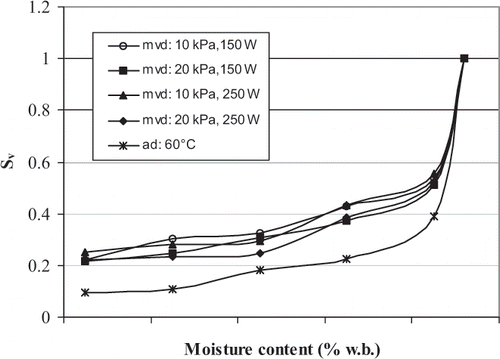
Table 1 Shrinkage ratio and apparent densities of button mushrooms at different moisture content.
Table 2 Correlation constants of the linear model representing the shrinkage of mushrooms at various drying conditions.
From and , it can be observed that in microwave vacuum drying method, system pressure had more pronounced effect on shrinkage than that obtained by changing the microwave power level. A univariate ANOVA of shrinkage ratio revealed a high significant effect (P < 0.001) for the pressure levels, moisture content and drying methods. Less shrinkage during microwave vacuum drying at lower pressure may be attributed to more puffing effect of the product when the pressure difference was more. Alternately, the shrinkage ratio was calculated from the density data () by using the model EquationEq. (7) and plotted in . Values of shrinkage ratio predicted by the model reasonably reproduced experimental data with standard errors of less than 8% for all the cases.
Figure 5 Experimental and predicted volumetric shrinkage ratio of mushrooms as a function of moisture ratio.
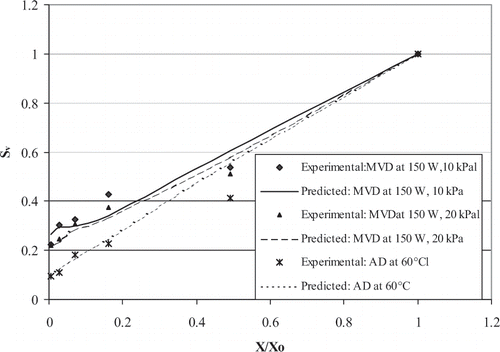
Changes in volumetric and diametric (linear) shrinkage with moisture ratio for both the drying method is shown in . Air-dried samples shrank more diametrically also as compared to microwave dried samples. Using regression analysis the exponent “y” in EquationEq. (2) was calculated from the values of Sv and Sd. A good fit was obtained as represented by a correlation coefficient of 0.997 for air-drying and 0.995 for microwave vacuum drying and the corresponding values of “y” were found to be 2.67 and 2.73 respectively. As the values are close to 3, a three-dimensional isotropic shrinkage may be assumed in the case of drying of whole mushrooms.[Citation15]
Using the shrinkage data, the apparent densities at different moisture content was calculated according to model EquationEq. (10). The experimental and predicted apparent density curves are depicted in . Apparent density was found to decrease as the water was removed from the mushrooms and was strongly affected by the method of drying. The values of apparent density were noticed to be much lower in microwave-vacuum dried sample as compared to air-dried samples. This is because the more porous nature of the microwave-dried samples. The model predicted the bulk density well. The standard relative error was found to be in the range of 3.9 to 4.8% for microwave-vacuum drying and 6.05% for air drying, which are lower than the acceptable engineering accuracy of 10%.
CONCLUSIONS
There were significant volume changes during mushroom drying, and shrinkage should not be neglected while modeling mushroom drying processes. Shrinkage in mushroom was less during microwave-vacuum compared to the air-drying method, and the system pressure level had more significant effect on shrinkage than the microwave power level. The regression analysis gave a correlation of a straight line between the shrinkage ratio and moisture ratio for the specific experimental conditions. The proposed model to predict apparent density, which uses only the shrinkage parameters and initial density, showed a good agreement with experimental data as revealed from the values of standard relative error of less than 6%.
NOMENCLATURE
| D | = |
Diffusion co-efficient |
| V | = |
Volume |
| S | = |
Shrinkage ratio |
| ρa | = |
Apparent density |
| m | = |
Mass |
| X | = |
Moisture content, dry basis |
| Xw | = |
Moisture content, wet basis |
| L | = |
Thickness |
| Φ | = |
Diameter |
| A | = |
Constant |
| B | = |
Coefficient |
| MVD | = |
Microwave-vacuum drying |
| AD | = |
Air drying |
Subscript
| 0 | = |
Initial value |
| v | = |
Volume |
| d | = |
Diameter |
| s | = |
Solid |
| w | = |
Water |
| eff | = |
Effective |
| ref | = |
Reference |
REFERENCES
- Karel , M. 1991 . “ Physical Structure and Quality of Dehydrated Foods ” . In Drying 91 , 26 – 35 . Amsterdam, , Netherlands : Elsevier Science Publishers BV .
- Rahman , M.S. 2001 . Towards prediction of porosity in foods during drying: a brief review . Drying Tech. , 19 ( 1 ) : 1 – 13 .
- Ratti , C. 1994 . Shrinkage During Drying of Foodstuffs . J. Food Eng. , 25 : 91 – 105 . [CROSSREF]
- Wang , N. and Brennan , J.G. 1995 . Changes in structure, density and porosity of potato during dehydration . J. Food Engineering , 24 : 61 – 76 . [CROSSREF]
- Lin , T.M. , Durance , T.D. and Scaman , C.H. 1998 . Characterization of vacuum microwave, air and freeze dried carrot . Food Res. Int. , 31 ( 2 ) : 111 – 117 . [CROSSREF]
- Rahman , M.S. and Perera , C.O. 1999 . “ Drying and Food Preservation ” . In Handbook of Food Preservation , Edited by: Rahman , M.S. New York : Marcel Dekker .
- O'Neill , M.B. , Rahman , M.S. , Perera , C.O. , Smith , B. and Melton , L.D. 1998 . Color and density of apple cubes dried in air and modified atmosphere . Int. J. Food Properties , 1 ( 3 ) : 197 – 205 .
- Khraisheh , M.A.M. , Cooper , T.J.R. and Magee , T.R.A. 1997 . Shrinkage characteristics of potato dehydrated under combined microwave and convective air conditions . Drying Tech. , 15 ( 3, 4 ) : 1003 – 1022 .
- Lozano , J.E. , Rotstein , E. and Urbicain , M.J. 1983 . Shrinkage, porosity and bulk density of foodstuffs at changing moisture contents . J. Food Sci. , 48 : 1497 – 1553 .
- Balban , M. and Pigott , G.M. 1986 . Shrinkage in fish muscle during drying . J. Food Sci , 51 ( 2 ) : 510 – 511 .
- Teotia , M.S. and Ramakrishna , P. 1989 . Densities of melon seeds, kernels and hulls . J. Food Eng. , 9 : 231 – 236 . [CROSSREF]
- Rahman , M.S. and Potluri , P.L. 1990 . Shrinkage and density of squid flesh during air drying . J. Food Eng. , 12 ( 2 ) : 133 – 143 . [CROSSREF]
- Lang , W. , Sokhansanj , S. and Sosulski , F.W. 1993 . Comparative drying experiments with instantaneous shrinkage measurements for wheat and canola . Canadian Agril. Eng. , 35 ( 2 ) : 127 – 132 .
- Tulsidas , T.N. Combined convective and microwave drying of grapes . Ph.D. thesis submitted to McGill University .
- Sjoholm , I. and Gekas , V. 1995 . Apple shrinkage upon drying . J. Food Eng. , 25 ( 1 ) : 123 – 130 . [CROSSREF]
- Raghavan , G.S.V. and Venkatachalapathy , K. 1999 . Shrinkage of Strawberries During Microwave Drying . Drying Tech , 17 ( 10 ) : 2309 – 2321 .
- Crank , J. 1975 . The mathematics of diffusion , Oxford, , UK : Clarendon Press .
- Fish , B.P. 1958 . “ Diffusion and thermodynamics of water in potato starch gel ” . In Fundamental Aspects of the dehydration of foodstuffs , 143 – 157 . London : Society of Chemical Industry .
- Gekas , V. , Motarjemi , Y. , Lamberg , I. and Hallstrom , B. 1988 . Preconcentration and Drying of Food Materials , Edited by: Buin , S. 317 – 319 . Amsterdam, , The Netherlands : Elsevier Science Publishers BV .
- Gekas , V. and Lamberg , I. 1991 . Determination of diffusion coefficients in volume changing systems—Application in the case of potato drying . J. Food Eng. , 14 : 317 – 336 . [CROSSREF]
- Madamba , P.S. , Driscoll , R.H. and Buckle , K.A. 1993 . Bulk density, porosity and resistance to airflow of garlic slices . Drying Tech. , 11 ( 7 ) : 1837 – 1854 .
- Zogzas , N.P. , Maroulis , Z.B. and Marinos-Kouris , D. 1994 . Densities, shrinkage and porosity of some vegetables during air drying . Drying Tech. , 12 ( 7 ) : 1653 – 1666 .
- Rahman , M.S. , Perera , C.O. , Chen , X.D. , Driscoll , R.H. and Potluri , P.L. 1996 . Density, shrinkage and porosity of calamari mantle meat during air drying in a cabinet dryer as a function of water content . J. Food Eng. , 30 : 135 – 145 . [CROSSREF]
- Rahman , M.S. 2003 . A theoretical model to predict the formation of pores in foods during drying . Int. J. Food Properties , 6 ( 1 ) : 61 – 72 . [CROSSREF]
- Moreira , R. , Figueiredo , A. and Sereno , A. 2000 . Shrinkage of apple disks during drying by warm air convection and freeze drying . Drying Tech. , 18 ( 1, 2 ) : 279 – 294 .
- Ranganna , M.S. 1986 . Handbook of Analysis and Quality Control for Fruits and Vegetables Products , New Delhi : McGraw Hill Publishing Co. Ltd. .
- Sharma , G.P. and Prasad , S. 2001 . Drying of garlic (Allium sativum) cloves by microwave-hot air combination . J. Food Eng. , 50 : 99 – 105 . [CROSSREF]
